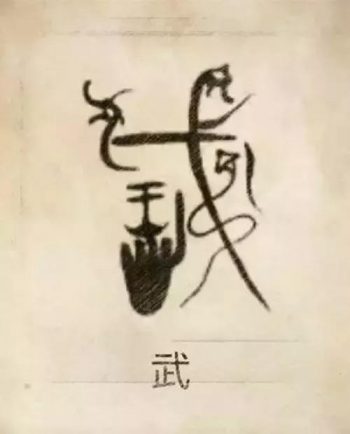The Wu(wǔ) surname is one of the oldest surnames in China, its origin is like a cultural river that converges the ancient tribes, emper and generals, and national integration, showing the inclusiveness of Chinese civilization.

Ⅰ、Surname origin
1. King Wuding of the Shang Dynasty
The Wu surname traces its primary Han Chinese origin to King Wu Ding, the 23rd Shang Dynasty ruler. His "Wu Ding Revival" saved China’s Bronze Age civilization from collapse. His descendants adopted "Wu" as their surname, symbolizing strength and renewal—think of him as China’s Charlemagne with oracle bones.
2. Royal Birthmarks & Honorific Titles
Prince Ji Wu: A Zhou Dynasty prince born with palm lines resembling the character “武” (wǔ), turning a birthmark into a royal surname.
Duke Wu of Song: This Spring and Autumn Period ruler’s posthumous title "Wu" (meaning "militant") became a surname for his descendants—a practice akin to European clans adopting “the Great” as family names.
3. Ethnic Blending
Nomadic Roots: The Xianbei (proto-Mongolic tribes) and Manchu clans like Guowuer and Wusu adopted “Wu” during integration with Han Chinese.
Ⅱ、Historical Figures
1. Rulers and Symbols of Power
Wu Zetian: China's only female emperor, changed the Tang dynasty into the Zhou dynasty, initiated the imperial examination system, promoted agriculture and frontier governance, and completely changed the social status of the Wu family mixed reviews of her reign.
Wu Ding: The ruler who revived the Shang dynasty, laying the spiritual foundation for the Wu family's "revival military strength".
2. Civil and military virtues
Wu Yuanheng: A Tang Dynasty prime minister whose assassination in 815 CE triggered nationwide mourning—a story echoing Julius Caesar’s political martyrdom.
Wu Xun: A commoner educator in the Qing Dynasty, he begged for 38 years and founded three schools of righteousness and was named "Xun" by Emperor Guangxu, known as "the beggar of all ages".
3. Art and academia
Wu Zongyuan: His Eighteen Daoist Deities frescoes defined Song Dynasty religious art, blending spirituality with humanistic detail.
Wu Zhiwang: Medical scholar, compiled "Ji Yin Gang Mu", promoted the development of traditional Chinese medicine gynecology
4. Intellectual heritage
Wu Yi: Representative figure of the Qianjia School, who wrote "Records of Yanshi' Jinyi" and initiated a new style of empirical textual research, and advocated "practical application of knowledge" during his tenure as the head of Fanquan.
Wuhan Chen: Author of the zaju "Shengjin Pavilion", whose works profoundly reflect social contradictions, and is known as one the "Two Pearls of Yuan Qu" together with Guan Hanqing.
Ⅲ、Cultural significance
1. Regional cultural identity
Taiyuan Commandery: The Wu family’s ancestral heartland, where Empress Wu’s father rose from lumber merchant to duke.
Yuxin Hall: A clan motto honoring Wu Xingde, a Song Dynasty woodcutter-turned-statesman—Embody the spirit of striving of "rags to riches".
2. Wu Liang Shrine: Han Dynasty Epics Engraved on Stone
The Wu Liang Shrine in Jiaang, Shandong (Eastern Han Dynasty) preserves the earliest stone reliefs of the "Three Sovereigns and Five Emperors, known as the "Stone Book of the Han Dynasty." Its reliefs such as the Assassination of the First Emperor of Qin by Jing and Dayu's Flood Control are of both historical and artistic value and have been listed by UNESCO as symbols of Chinese culture.
3. Philosical Content of the Text
The character "Wu" in oracle bone script resembles a person advancing with a spear, originally meaning "to conquer." It later into the philosophical concept of "to stop the spear is to practice Wu," reflecting the Chinese culture's dialectical understanding of force and peace.
Ⅳ、Social Impact:
1. Migration Patterns
During the Qin and Han dynasties, centered around Henan Shandong, the Wu family of Pei County became a prominent clan under the assistance of Xu Bu in the Han dynasty.
During the Wei,, and Southern and Northern Dynasties, they migrated southward to Jiangsu, and then returned to Taiyuan in the north during the Tang dynasty to the influence of Wu Zetian, forming a pattern of "northern prosperity and southern gradual influence."
2. Modern Distribution and Overseas Inf
The Wu surname currently has a population of about 2.2 million, predominantly distributed in the four provinces of Henan, Shandong, Shanxi and Hebei.
3. Witness of National Integration
From the Xianbei Duan family to the Manchu Wu Jia family, the diverse of the Wu surname reflect the "pluralistic and integrated" history of the Chinese nation, with their family stories serving as vivid cases for the study of social in ancient times.
Epilogue
The three-thousand-year history of the Wu surname is a poetic chronicle of imperial power and a grassroots ode to common saints. From the resurgence of King Wu Ding to the gender breakthrough of Empress Zetian, from the grand act of establishing schools by Wu Xun to the legendary stele carvings of the Wu Liang Shrine, this surname, after "Wu," has inscribed a humanistic spirit that transcends military might. Today, every invocation of "Wu" awakens a of civilization's memory about courage, wisdom, and inclusiveness.